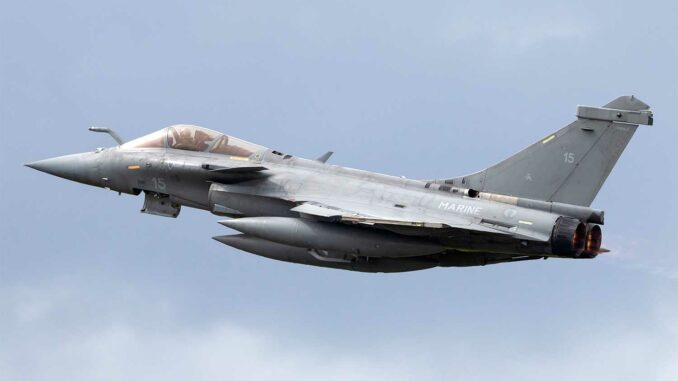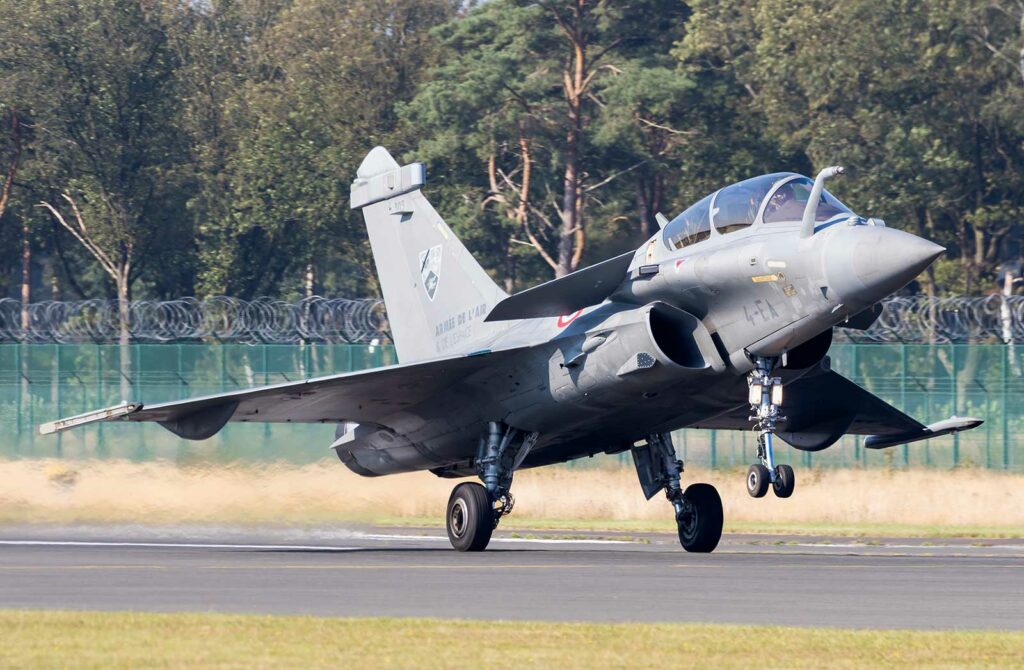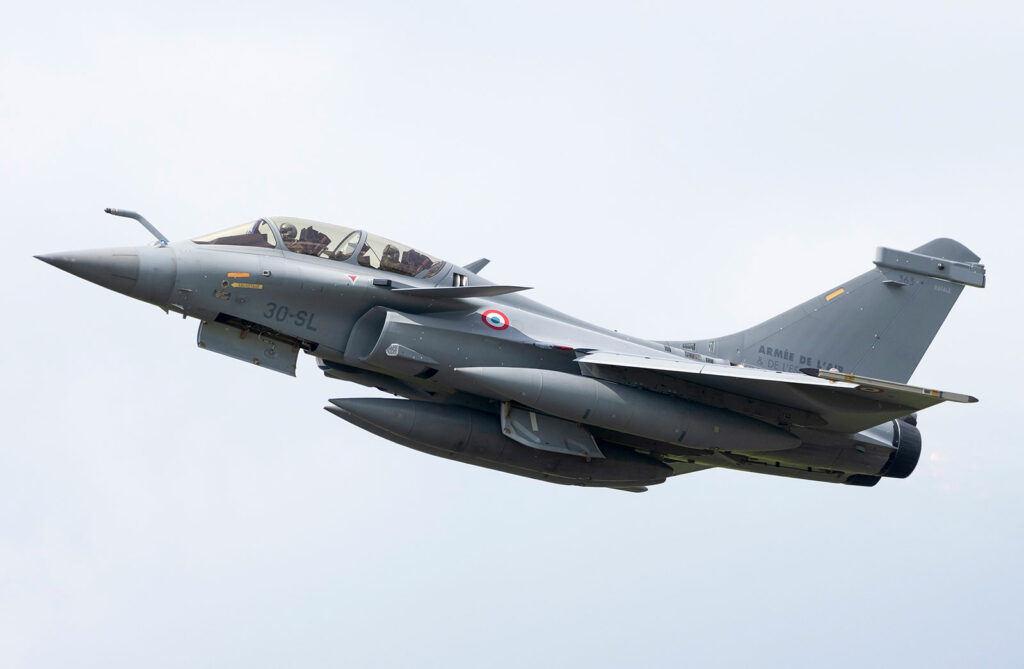
Analysis of the flaws of the Rafale, standard by standard, from the F1 version to the future F5: technical limitations, cost, stealth, and international competition.
The Rafale, designed by Dassault Aviation, has become the centerpiece of French combat aviation. Often presented as a versatile and high-performance aircraft, it nonetheless suffers from flaws specific to each standard. From the F1 version, limited to air combat, to the future F5 designed for collaborative combat, the Rafale has undergone a gradual evolution fraught with technical and operational constraints. This article provides a detailed analysis of the limitations encountered by each standard, putting into perspective the challenges faced by international competitors.
Rafale F1 (entered service in 2001, Navy version only)
- Mission limitations: only capable of air-to-air missions (interception, air defense). No air-to-ground or reconnaissance capabilities.
- Reduced avionics capabilities: SPECTRA electronic warfare system still incomplete.
- Limited RBE2 PESA radar: poor performance in tracking multiple targets, reduced range compared to equivalent American or Russian radars at the time.
- Initial reliability: immature standard, resulting in higher maintenance costs and operational downtime.
→ Major flaw: versatile aircraft on paper, but in reality a limited interceptor, which led to criticism within the French Navy.

Rafale F2 (2004, Air Force and Navy)
- Incomplete versatility: introduction of air-to-ground capabilities, but no nuclear deterrence or anti-ship capabilities yet.
- Limited payload: partial integration of weapons (GBU-12, Scalp, AASM) not yet fully operational.
- Radar still PESA: still inferior to American AESA (F-15E, F-16 Block 60).
- Lack of operational maturity: logistics and technical support still in the early stages, high cost per flight hour.
→ Major flaw: promised versatility but incomplete, and aircraft still perceived as “under development”.
Rafale F3 (2008, then F3-O4T modernized in 2014)
- Complete versatility: nuclear strike (ASMP-A), anti-ship (Exocet), reconnaissance (Pod Reco NG), but:
- RBE2 radar still PESA on the first F3s → inferior in range/detection to competitors equipped with AESA (F-35, F-22, modernized F-15).
- Limited stealth capability: optimized airframe but no stealth design, radar visibility superior to 5th generation stealth fighters.
- NATO interoperability still limited at launch (datalinks, cryptos).
- Technical availability: high maintenance costs, availability issues reported in the early years.
→ Major flaw: finally an “omni-role” aircraft, but suffering from aging radar and heavy maintenance.
Rafale F3R (2018)
- RBE2 AESA radar finally widespread, but:
- More powerful, but still lower range than large American AESA radars (APG-77, APG-81, APG-82).
- Improved weapon integration (Meteor, Talios, AASM), but:
- Heavy dependence on French weapons, making export more complex (little integration of standard NATO weapons).
- Stealth capabilities unchanged: still lagging behind the F-35 on this criterion.
- High cost per flight hour (approximately $16,000–18,000 according to sources), more expensive than lighter aircraft (Gripen E).
→ Major flaw: successful modernization but expensive aircraft and still not stealthy against modern threats.
Rafale F4 (development launched in 2019, gradual entry into service 2025-2030)
- Planned improvements: new data links, artificial intelligence for sensor processing, enhanced weaponry, reinforced SPECTRA.
- But:
- Delays: initial operational capabilities not expected until 2025 → slow ramp-up.
- Lack of stealth design (compared to the F-35, J-20, and Su-57).
- Dependence on sophisticated support infrastructure: increased logistical complexity.
- Increased competition: the Rafale F4 may arrive when the 6th generation (SCAF, NGAD) is already in advanced development.
→ Major flaw: risk of partial obsolescence compared to 5th generation stealth fighters already widely exported.
Rafale F5 (planned after 2030)
- High ambitions: networking with combat drones, collaborative warfare, improved sensors, integration of new hypersonic weapons.
- But challenges ahead:
- Extreme complexity of collaborative architectures (MUM-T) → long and costly integration.
- Dependence on SCAF: if the tri-national program falls behind schedule, the Rafale F5 could remain “between two generations.”
- Still not a native stealth fighter, which will put it at a disadvantage in highly contested environments.
→ Major flaw: risk of being a costly transition to SCAF, without being a true 6th generation fighter.

Overall assessment of the Rafale’s flaws
- Lack of stealth design: remains a 4.5th generation aircraft, optimized but not at the level of the F-35 or J-20.
- Radar: long limited to PESA, AESA arrived late and remains smaller than American radars.
- High cost of ownership: more expensive than the Gripen E or F-16V.
- Technical availability: progress has been made, but there are recurring criticisms of the MCO (maintenance in operational condition).
- Limited weapons integration: focused on French weapons, less open than an F-16, for example.
Standard Rafale shortcomings by standard
| Standard | Main capabilities | Major shortcomings | Competition at the time |
|---|---|---|---|
| F1 (2001) | Air-to-air only (Navy) | – No air-to-ground or reconnaissance missions – Limited RBE2 PESA radar – Incomplete SPECTRA – Poor initial reliability | F/A-18C/D, F-16C/D, modernized Su-27 |
| F2 (2004) | Air-to-air + initial air-to-ground capabilities | – Incomplete versatility – Radar still PESA (inferior to US AESA) – Immature logistical support – High cost per flight hour | F-15E Strike Eagle, F-16 Block 50/60, Typhoon Tranche 1 |
| F3 (2008, F3-O4T in 2014) | Full multi-role (nuclear, anti-ship, reconnaissance) | – PESA radar still present on many aircraft – Limited stealth – Restricted NATO interoperability initially – Low technical availability at launch | F-35 in development, modernized F-15s, Su-30MKI |
| F3R (2018) | Generalized AESA, Meteor, Talios, AASM | – AESA radar smaller/less powerful than US APG-81/82 – Not stealthy against 5th gen – Dependence on French weapons (few NATO weapons integrated) – High operating costs | F-35A/B in service, Gripen E, Su-35 |
| F4 (2025-2030) | Enhanced connectivity, AI sensors, improved SPECTRA, new weapons | – Schedule delays – No native stealth – Increased logistical complexity – Risk of obsolescence in the face of already mature 5th generation aircraft | F-35 Block 4, Chinese J-20, Russian Su-57 |
| F5 (after 2030) | Collaborative combat with drones, new hypersonic weapons, networked warfare | – Complex integration (MUM-T) – Dependence on SCAF/NGF – Still not stealthy by design – Risk of being a costly transition before 6th gen | NGAD (USA), SCAF/NGF (Europe), FCAS (UK-Japan-Italy) |
Each Rafale standard has corrected the weaknesses of the previous one, but two structural flaws remain:
- No stealth design, which limits it against 5th generation fighters.
- High operating costs compared to some lighter competitors.
A highly effective aircraft despite its flaws
Despite its flaws, the Rafale remains one of the most effective fighter jets of its generation. Designed as an multi-role aircraft, it can switch from air superiority missions to precision strikes or nuclear missions without major modifications. This versatility, rare even among its direct competitors, makes it a major asset for the forces that use it.
In air combat, its exceptional handling, thanks to an optimized airframe and digital flight control, gives it great agility against heavy fighters such as the Su-35 or the Eurofighter Typhoon. The arrival of AESA radar and the Meteor missile has reinforced its air superiority, with a firing range that rivals that of the best Western aircraft.
Its SPECTRA electronic warfare systems are considered among the most effective in the world, offering active and passive protection that partially compensates for the lack of native stealth. In addition, the Rafale has proven itself in real operations in Afghanistan, Libya, Mali, Iraq, Syria, and Ukraine (via transfers), demonstrating recognized reliability and operational effectiveness.
Compared to the F-35, it remains less stealthy but has the advantage of being more versatile in terms of weaponry and less dependent on heavy logistical support. Compared to the Gripen E, it is more expensive but significantly more powerful and interoperable in many theaters. The Rafale retains the ability to compete effectively with its competitors when properly integrated into an operational system.
War Wings Daily is an independant magazine.